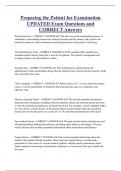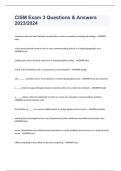Preparing the Patient for Examination
UPDATED Exam Questions and
CORRECT Answers
Patient interview - CORRECT ANSWER-✔✔ The first step in the examination process. It
establishes a relationship between the medical assistant and the patient, and it allows the
medical assistant to collect information and data pertinent to the patient's well-being.
The health history form - CORRECT ANSWER-✔✔ The medical office usually has a
standard medical history form that it uses for all patients. The specific arrangement and
wording of items vary from office to office.
Personal data - CORRECT ANSWER-✔✔ This information is obtained from the
administrative sheet and includes things like the patient's name, Social Security number, birth
date, and other basic data.
Chief complaint - CORRECT ANSWER-✔✔ Abbreviated as CC, it is the reason the patient
came to visit the practitioner. It should be short and specific and cover subjective and
objective data.
History of present illness - CORRECT ANSWER-✔✔ This includes detailed information
about the chief complaint, including when the problem started and what the patient has done
to treat the problem (including any medications taken). For example, a chief complaint might
be "sore throat," and the history of the present illness would include when the sore throat
started, how severe the pain is on a scale of 1 to 10, and what treatments have been used.
Past medical history - CORRECT ANSWER-✔✔ The past medical history includes any and
all health problems both present and past, including major illnesses and surgery. The past
medical history also includes important information about medications and allergies.
Family history - CORRECT ANSWER-✔✔ This section includes information about the
health of the patient's family members. Many times the family history can help lead a
practitioner to the cause of a current medical problem. Obtain specific information about
family members' current ages and medical conditions or, if deceased, their age at death and
the cause.
,Social and occupational history - CORRECT ANSWER-✔✔ Information such as marital
status, sexual behaviors and orientation, occupations, hobbies, and use of chemical
substances help determine a patient's risk for disease. Patients should be asked about their use
of alcohol, tobacco, recreational drugs, or other chemical substances.
Six Cs of charting - CORRECT ANSWER-✔✔ •Client's words—The patient's own phrasing
must be recorded exactly.•Clarity—Use precise medical terminology.
•Completeness—The chart must contain all pertinent information.•Conciseness—Use
abbreviations where you can to save time and space.•Chronological order—Date all
entries.•Confidentiality—Protect the patient's privacy.
Interviewing successfully - CORRECT ANSWER-✔✔ Do your research before the
interview. Review the patient's medical history. Plan the interview. Plan what types of
questions you want to ask. Approach the patient and request an interview. Make the patient
feel part of the process. Make the patient feel at ease. Use icebreakers and casual
conversation.Listen to the patient.Conduct the interview in private without interruption. Do
not diagnose or give a diagnostic opinion. Summarize key points, and let the patient ask
questions.
Methods that can further help you collect patient data include - CORRECT ANSWER-✔✔
Asking open-ended and hypothetical questions, mirroring the patient's explicit responses and
verbalizing the implied responses, focusing on the patient, encouraging the patient to take the
lead, encouraging the patient to provide additional information, and encouraging the patient
to evaluate the situation. Make sure that you do not challenge the patient or probe in a manner
that invades the patient's privacy.
Detect nonverbal clues - CORRECT ANSWER-✔✔ During the preexamination interview,
you may note things that patients have not communicated to you verbally, such as anxiety,
depression, signs of physical or psychological abuse, and signs of drug or alcohol abuse. If
you suspect abuse, bring it to the physician's attention immediately. Provide such patients
with support, advice, and the appropriate hotline number for your area if they want to seek
help.
Purpose of the physical examination - CORRECT ANSWER-✔✔ The determination of the
general state of health of the patient and the diagnosis of any medical problems and diseases
the patient may have. The physician uses a variety of devices and laboratory tests to complete
the physical findings. The majority of physicians usually start at the patient's head and end at
the feet. Sometimes the physician may order some additional tests or procedures, such as
blood sample testing, the collection of culture specimens, or X-rays.
, Complete physical examination - CORRECT ANSWER-✔✔ Includes vital signs,
examination of the patient's entire body, laboratory tests (complete blood count [CBC] and
urinalysis); and diagnostic tests (X-rays).
Duty of a medical assistant - CORRECT ANSWER-✔✔ Preparing the room and equipment,
getting the patient ready, and assisting the physician.
Emotional preparation - CORRECT ANSWER-✔✔ Begin by explaining what will happen
during the examination. This step is especially important when dealing with children.
Physical preparation - CORRECT ANSWER-✔✔ The medical assistant is responsible for
obtaining and recording weight, height, and vital signs; facilitating the examination; asking
the patient to empty his or her bladder; asking the patient to disrobe completely; providing
the patient with a full gown; and providing a drape sheet.
Examination methods - CORRECT ANSWER-✔✔ The six methods for examining a patient
that are a part of a complete physical examination are inspection, palpation, percussion,
auscultation, manipulation, and mensuration.
Inspection - CORRECT ANSWER-✔✔ Observing the patient's outer body and certain mental
characteristics.
Palpation - CORRECT ANSWER-✔✔ Feeling with the fingers or hand to verify data seen
during inspection.
Percussion - CORRECT ANSWER-✔✔ Tapping with the fingers and listening for sounds,
particularly in the abdomen, back, and chest.
Auscultation - CORRECT ANSWER-✔✔ Listening to sounds with a stethoscope.
Manipulation - CORRECT ANSWER-✔✔ Skillfully using the hands in therapeutic or
diagnostic procedures.





